Filtered by: Lifestyle
Lifestyle
Who was Teodulo Protomartir?
By Uro dela Cruz
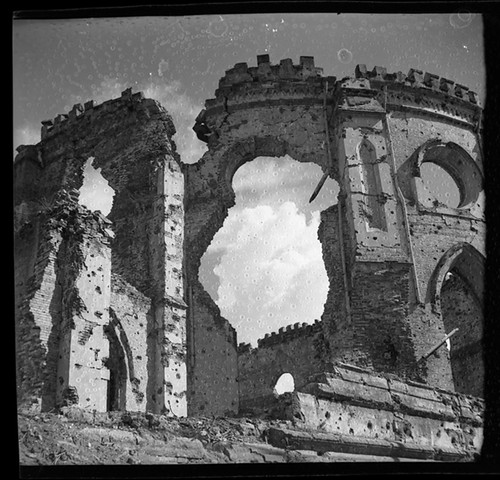 One of the most interesting things about the photos taken by Teodulo Protomartir is that they were almost lost forever. It was in 2007 when the withering negatives, already more than 60 years old, were serendipitously discovered in an antique shop by a collector of old cameras named Uro dela Cruz. While most people may know Dela Cruz for his work as the director of wildly popular TV shows like Bubble Gang and as the screenwriter of such films as "Scorpio Nights" and "Unfaithful Wife", fewer know that he is also an avid photographer who is passionate about using film. In today's world, the ubiquitous digital camera has turned nearly everyone into an amateur photographer. But film loyalists like Dela Cruz have not forgotten that once upon a time, only a pioneering few were patient, resourceful, and dedicated enough to pursue the craft of turning celluloid into pictures. One of those few was Teodulo Protomartir, one of the first Filipinos to popularize the use of 35-mm film in the Philippines. Over a period of two years since late 2007, Dela Cruz patiently scanned and preserved the negatives, hoping that one day there would be an opportunity to share them with the world. That opportunity arose a few months ago when he met Isa Lorenzo, the personality behind the Philippines' premiere photo gallery, Silverlens. The two worked together to select and scan around 50 of Protomartir's photos of post-war Manila, taken between May and June 1946. The exhibit, entitled, "Being There 1946: The Legacy of Teodulo Protomartir" opened last Wednesday, June 9, and will be on display until July 3. In this blog entry written in 2007, Dela Cruz writes about the happy privilege of saving Protomartir's work from oblivion. -Pia Faustino, GMANews.TV ---
One of the most interesting things about the photos taken by Teodulo Protomartir is that they were almost lost forever. It was in 2007 when the withering negatives, already more than 60 years old, were serendipitously discovered in an antique shop by a collector of old cameras named Uro dela Cruz. While most people may know Dela Cruz for his work as the director of wildly popular TV shows like Bubble Gang and as the screenwriter of such films as "Scorpio Nights" and "Unfaithful Wife", fewer know that he is also an avid photographer who is passionate about using film. In today's world, the ubiquitous digital camera has turned nearly everyone into an amateur photographer. But film loyalists like Dela Cruz have not forgotten that once upon a time, only a pioneering few were patient, resourceful, and dedicated enough to pursue the craft of turning celluloid into pictures. One of those few was Teodulo Protomartir, one of the first Filipinos to popularize the use of 35-mm film in the Philippines. Over a period of two years since late 2007, Dela Cruz patiently scanned and preserved the negatives, hoping that one day there would be an opportunity to share them with the world. That opportunity arose a few months ago when he met Isa Lorenzo, the personality behind the Philippines' premiere photo gallery, Silverlens. The two worked together to select and scan around 50 of Protomartir's photos of post-war Manila, taken between May and June 1946. The exhibit, entitled, "Being There 1946: The Legacy of Teodulo Protomartir" opened last Wednesday, June 9, and will be on display until July 3. In this blog entry written in 2007, Dela Cruz writes about the happy privilege of saving Protomartir's work from oblivion. -Pia Faustino, GMANews.TV --- This story started with just a single camera-- a Kodak folder from the 1930’s. 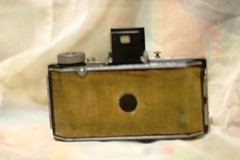 The camera that started it all.
The camera that started it all.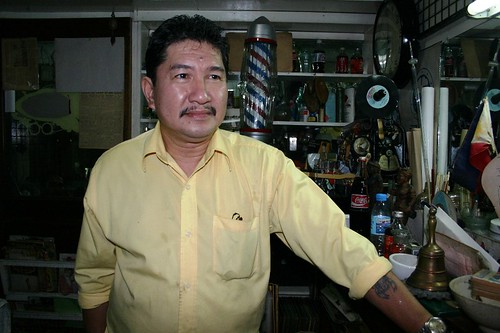 Sir George, the owner of SwapMeet on Kamuning.
Sir George, the owner of SwapMeet on Kamuning.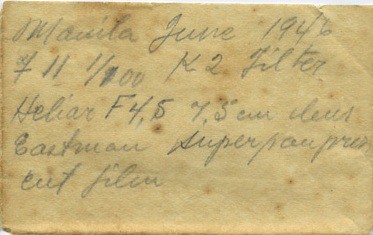 The inscriptions were faded, and looked like some hieroglyphs. Later, at home, I realized that they were, upon careful inspection, a guide to exposure with experimental combinations of aperture and shutter speeds. I cleaned the camera but did not touch the inscriptions, and then hid it in a box. Fast forward to a week ago. I was taping an episode of "Bitoy’s Funniest Videos" right in front of the SwapMeet in Kamuning. During the break, I crossed the street to visit the shop. There were no cameras for sale. Sir George said cameras are quite rare now. He remembered me, and showed me a pile of old photographs. I flipped through the photos which were carefully inserted in protective plastic envelopes. I saw a night shot of Avenida Rizal showing the marquees of the downtown theatres, and Anak Dalita was showing at the Dalisay theatre. I have been collecting pictures of old theatres which are not there anymore. I asked him who took the photo. And he mentioned that name again, followed by the honorific, Father of Philippine Photography. Then Sir George showed me an album with original black and white prints of different scenes around Manila from the 1930’s to the 50’s. They were pictures that fall under what modern photographers call street photography: children selling paper bags to shoppers around pre-war Plaza Miranda, policemen inspecting old style cars parked in front of Cine Metropolitan at the back of Quiapo Church, urchins running across the newly built bridge along R. Hidalgo near the corner of Arlegui, children playing at the beach in front of Dewey Boulevard, a Malate girl selling vegetables from a kaing… and all the photos have technical notes at the back: what film was used, which developer (Dr. Sease developer), what lens (all Leica mount lenses, some very rare) at which aperture. So who is this man? Who is Teodulo Protomartir? Sir George was a bit round-about in giving me answers. Mr. Protomartir had been dead for years now. His last photos were taken in the 70’s. I wanted to know more. But Sir George was more concerned about his difficulty in making copies of the photographs direct from the old, and now crumbling negatives. Some shops refused to scan the negatives because they were too brittle… and somebody even suggested to him that the large format negatives were already useless because they didn’t fit into their scanners. I immediately rushed to Jay Javier’s Fotofabrik studio which is just a stone's throw away from Kamuning. We rushed back and I showed him into the shop. “I have 30,000 photographic negatives, I don’t know how I can save them", Sir George sighed. Jay inspected some of the negatives. “Vinegar syndrome," he said after smelling the negatives. He’s the expert, and he was worried. We decided that something was to be done. We volunteered to scan all the negatives and clean them digitally. Once that was agreed upon, Jay and I became more relaxed and pored over the other albums. In one album, there were about 20 photographs of a young Teodulo Protomartir and a group of young photographers like him in what was evidently a photographic walkabout. And they were all proudly wearing 2-toned shoes and on their necks were rangefinder cameras. It was the 30’s, 35mm film was fairly new, and these young photographers were pioneering something that went against the norm, when large format cameras were the accepted tools of the medium.
The inscriptions were faded, and looked like some hieroglyphs. Later, at home, I realized that they were, upon careful inspection, a guide to exposure with experimental combinations of aperture and shutter speeds. I cleaned the camera but did not touch the inscriptions, and then hid it in a box. Fast forward to a week ago. I was taping an episode of "Bitoy’s Funniest Videos" right in front of the SwapMeet in Kamuning. During the break, I crossed the street to visit the shop. There were no cameras for sale. Sir George said cameras are quite rare now. He remembered me, and showed me a pile of old photographs. I flipped through the photos which were carefully inserted in protective plastic envelopes. I saw a night shot of Avenida Rizal showing the marquees of the downtown theatres, and Anak Dalita was showing at the Dalisay theatre. I have been collecting pictures of old theatres which are not there anymore. I asked him who took the photo. And he mentioned that name again, followed by the honorific, Father of Philippine Photography. Then Sir George showed me an album with original black and white prints of different scenes around Manila from the 1930’s to the 50’s. They were pictures that fall under what modern photographers call street photography: children selling paper bags to shoppers around pre-war Plaza Miranda, policemen inspecting old style cars parked in front of Cine Metropolitan at the back of Quiapo Church, urchins running across the newly built bridge along R. Hidalgo near the corner of Arlegui, children playing at the beach in front of Dewey Boulevard, a Malate girl selling vegetables from a kaing… and all the photos have technical notes at the back: what film was used, which developer (Dr. Sease developer), what lens (all Leica mount lenses, some very rare) at which aperture. So who is this man? Who is Teodulo Protomartir? Sir George was a bit round-about in giving me answers. Mr. Protomartir had been dead for years now. His last photos were taken in the 70’s. I wanted to know more. But Sir George was more concerned about his difficulty in making copies of the photographs direct from the old, and now crumbling negatives. Some shops refused to scan the negatives because they were too brittle… and somebody even suggested to him that the large format negatives were already useless because they didn’t fit into their scanners. I immediately rushed to Jay Javier’s Fotofabrik studio which is just a stone's throw away from Kamuning. We rushed back and I showed him into the shop. “I have 30,000 photographic negatives, I don’t know how I can save them", Sir George sighed. Jay inspected some of the negatives. “Vinegar syndrome," he said after smelling the negatives. He’s the expert, and he was worried. We decided that something was to be done. We volunteered to scan all the negatives and clean them digitally. Once that was agreed upon, Jay and I became more relaxed and pored over the other albums. In one album, there were about 20 photographs of a young Teodulo Protomartir and a group of young photographers like him in what was evidently a photographic walkabout. And they were all proudly wearing 2-toned shoes and on their necks were rangefinder cameras. It was the 30’s, 35mm film was fairly new, and these young photographers were pioneering something that went against the norm, when large format cameras were the accepted tools of the medium. 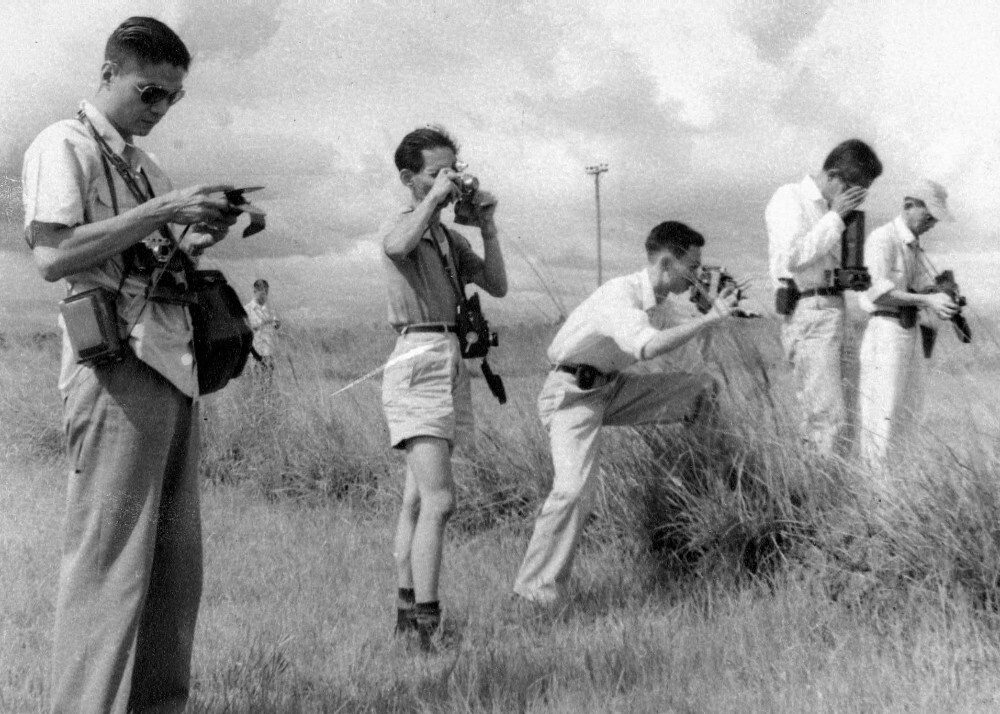
 Protomartir in one of his last photographs, sometime during the 1970's.
Protomartir in one of his last photographs, sometime during the 1970's.
 The camera that started it all.
The camera that started it all. Sir George, the owner of SwapMeet on Kamuning.
Sir George, the owner of SwapMeet on Kamuning.

 Protomartir in one of his last photographs, sometime during the 1970's.
Protomartir in one of his last photographs, sometime during the 1970's.-Uro dela Cruz, October 2007
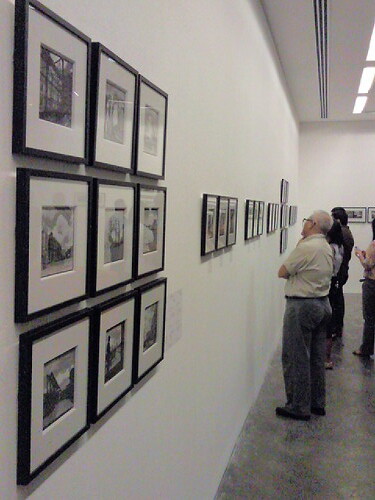
More Videos
Most Popular




